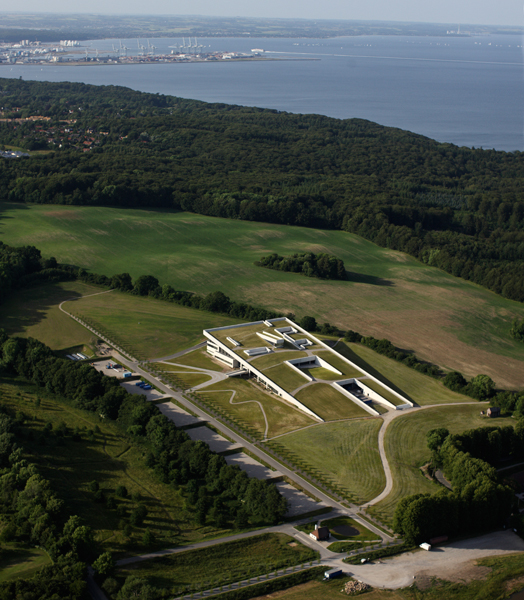Info & Images:
Courtesy Henning Larsen Architects
The Moesgaard
Museum is in news again – having won the Civic Trust Award 2015 for demonstrating
excellence in architecture and making a positive social, cultural,
environmental and economic impact on the local community.
Designed by
Henning Larsen Architects in collaboration with Architects Kristine
JensensTegnestue, the 16,000 sq. m. museum is uniquely located in the hilly
landscape of Skåde south of Aarhus, Denmark. With its rectangular-shaped
sloping roof plane that seems to grow out of the landscape of grass, moss and
flowers in bright colours, the building appears a powerful visual landmark
perceptible even from the sea.
.jpg) |
| . |
Architecture,
nature, culture and history fuse together into a total experience here. With
its green roof, bright courtyard gardens, and underground terraces, the museum
invites various new and alternative kinds of exhibitions. The project makes an
outstanding contribution to the quality and appearance of the environment.
.jpg) |
©Jens Lindhe
|
The interior of
the building is designed like a varied terraced landscape inspired by
archaeological excavations gradually unearthing the layers of history and
exposing lost cities. It stands under
one great concrete roof, gathering all of the different functions of the
building in one big scenic movement.
.jpg) |
©Martin Schubert
|
The heart of the
museum – a 750 sq.m.foyer houses the ticket counter, a café and a wardrobe. But
mainly, it connects the exhibition halls of the museum and gives access to the
many terraces with views overlooking the bay and the surrounding landscape.
.jpg) |
©Martin Schubert
|
Neutrality in
the architecture of the exhibition halls creates the perfect settings for the
proposed changing exhibitions. Additionally, high standards for logistics,
safety and climate control make an ideal environment for large-scale,
international exhibitions. The materials used harmonise with the overall
expression of the building, with due diligence to acoustics, economy, technical
settings, maintenance, durability, colour options and sustainability.
.jpg) |
©Jens Lindhe
|
Fundamental
elements such as the building's geometry and orientation are considered in
order to maximise every square metre – integrating a comprehensive sustainable
strategy. The south-facing roof surface (roof facade) forms the calculated
basis for this energy-efficient building, which achieves Energy Class 1 status.
 |
©Jan Kofod
Winther
|
Whilst the green
roof contributes to decreasing the energy consumption of the building and reduces
the overall need for cooling due to decreased heat absorption, the overall
amount of wastewater draining from the site is also reduced.
.jpg) |
| . |
The roof slopes
downwards to the south, protecting the objects on display from direct sunlight.
Connected to each exhibition room, a glass-enclosed area functions as a break
room - allowing visitors to enter, but preventing direct sunlight from reaching
the objects on display. In these spaces, visitors can have a bright respite
from the dark of the exhibition spaces and reorient to nature and sunlight.
.gif) |
©Jens Lindhe
|
An optimal use
of daylight in the remaining part of the museum reduces the need for artificial
lighting, decreasing overall energy consumption. Around the administrative and
educational facilities - which are placed in the rising end of the building - small
yards in the building volume allow daylight to penetrate the roof.
Considered to be
much more than a monument of archaeological findings, the museum offers a
perfect setting for different social and cultural activities: Conferences,
concerts, talks and sport events, etc.
Moesgaard Museum
was recently shortlisted for the European Union Prize for Contemporary
Architecture 2015 - Mies van der Rohe Award along with 40 other projects. Last
year, the museum was awarded the reputable and coveted In-Situ Award.

.jpg)
No comments :
Post a Comment